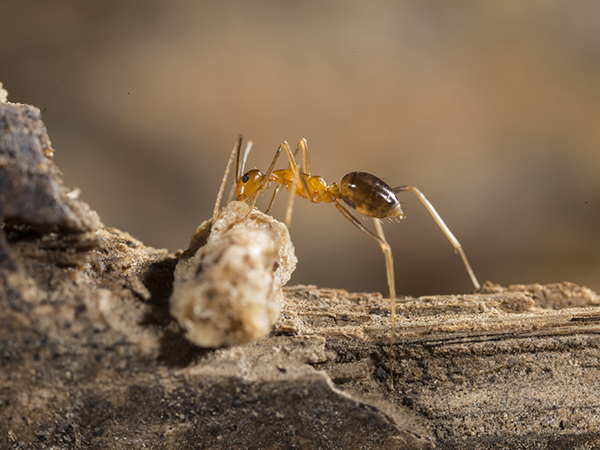Community crucial to funding
By Wet Tropics Management Authority
Crowdfunding and a small group of volunteers were once all that stood between Kuranda’s pristine World Heritage listed rainforest and one of the world’s 100 worst invasive species — yellow crazy ants.
In May 2016, it had been three years since the discovery of the area’s first yellow crazy ant infestation which had spread 30km from Cairns—via contaminated landscaping materials—to more than 53ha in Kuranda, Queensland.

A yellow crazy ant (Anoplolepis gracilipes) sniffs a bait pellet.
The Wet Tropics Management Authority’s Yellow Crazy Ant Eradication Program had been tackling infestations in and around the Wet Tropics World Heritage Area in Cairns and Kuranda since 2013, with a small budget and subsequent heavy reliance on volunteers.
In Kuranda, the ants threatened the critically endangered Kuranda tree frog (Litoria myola), local residents and their pets, some of which had fallen victim to the ants’ defence and attack mechanism: spraying formic acid.
Volunteer organisation Kuranda Envirocare recognised its community’s concerns, collaborating in 2015 with the Authority’s eradication program to establish a local taskforce providing labour for applying baiting treatments.
The taskforce achieved mixed results, engaging local farmers, residents and the tourism industry to promote vigilance against the acid-spraying ants.
It assisted to significantly reduce ant populations, but a lack of scientific research and resources kept eradication in Kuranda out of reach.
So, through crowdfunding efforts, Envirocare raised $20,000 for a James Cook University researcher to study the phenology and ecology of the ant.
This research injection notwithstanding, Kuranda Envirocare president Cathy Retter says the situation had reached a tipping point, until a welcomed State-Commonwealth funding alliance materialised.
In 2016, the Wet Tropics Management Authority received $7.5 million from the Commonwealth Government and $3 million from the Queensland Government in a joint package funding the Yellow Crazy Ant Eradication Program over three years.
“The additional funding meant they could put people on long-term employment and expand the teams on the ground,” Cathy said.
“Rather than the hand-to-mouth operation it had been, the funded program allowed a focus on evaluating strategies to determine the best treatment approach,” she said.
The new joint government investment came about largely as a result of the support, interest and concern of local residents.
Thanks to the joint funding arrangement, the Authority was able to grow the campaign to a team which now employs more than 30 staff and is trialling new methods of eradication. With one year of the current funding arrangement remaining, the program recently announced its first local eradication at a site south of Cairns.
It is the first of many local eradications to come in what is expected to be a 10-year path to eradication of yellow crazy ants from the Wet Tropics and surrounds.
Cathy says community support remains essential to ensuring the program stays the course to eradication.
“Ultimately it is always up to the community, whether it’s getting out into the field or advocating for funding. So far it has been a case of our community putting its best foot forward. We’re proud of our work so far and thankful we were heard,” she said.
The control of yellow crazy ant infestations in and adjacent to the Wet Tropics World Heritage Area is supported through funding from the Australian Government’s National Landcare Program and the Queensland Department of Environment and Science.
For more information, visit: wettropics.gov.au/what-are-yellow-crazy-ants
About yellow crazy ants
Yellow crazy ants are among the most invasive species found in the Wet Tropics of Queensland.
The exotic pest has invaded around 1,430 hectares of land in the region, including over 60 hectares of rainforest in and adjacent to the World Heritage Area.
Rather than bite or sting, the ants spray formic acid to kill their prey, making them a danger to threatened endemic species in the Wet Tropics. The 5mm ants can kill much larger prey and often work in large numbers referred to as ‘super-colonies’.



